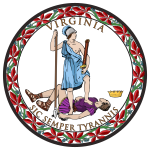| Elections in Virginia |
|---|
 |
Virginia elected its members in April 1817.
| District | Incumbent | This race | |||
|---|---|---|---|---|---|
| Representative | Party | First elected | Results | Candidates | |
| Virginia 1 | John G. Jackson | Democratic-Republican | 1803 1810 (Resigned) 1813 | Incumbent retired. New member elected. Federalist gain. | √ James Pindall (Federalist) 100% |
| Virginia 2 | Magnus Tate | Federalist | 1815 | Incumbent retired. New member elected. Federalist hold. | √ Edward Colston (Federalist) 61.2% Daniel Morgan (Democratic-Republican) 30.9% Robert Bailey (Democratic-Republican) 7.9% |
| Virginia 3 | Henry S. Tucker | Democratic-Republican | 1815 | Incumbent re-elected. | √ Henry S. Tucker (Democratic-Republican) 67.8% William Carson (Democratic-Republican) 32.2% |
| Virginia 4 | William McCoy | Democratic-Republican | 1811 | Incumbent re-elected. | √ William McCoy (Democratic-Republican) [lower-alpha 1] |
| Virginia 5 | James Breckinridge | Federalist | 1809 | Incumbent retired. New member elected. Democratic-Republican gain. | √ John Floyd (Democratic-Republican) 57.6 Elijah MacClannahan (Federalist) 42.4% |
| Virginia 6 | Daniel Sheffey | Federalist | 1809 | Incumbent retired. New member elected. Democratic-Republican gain | √ Alexander Smyth (Democratic-Republican) 67.0% Benjamin Estill (Federalist) 33.0% |
| Virginia 7 | Ballard Smith | Democratic-Republican | 1815 | Incumbent re-elected. | √ Ballard Smith (Democratic-Republican) 94.7% John Gray (Federalist) 5.3% |
| Virginia 8 | Joseph Lewis Jr. | Federalist | 1803 | Incumbent retired. New member elected. Federalist hold. | √ Charles F. Mercer (Federalist) 52.6% Armistead Mason (Democratic-Republican) 47.4% |
| Virginia 9 | John P. Hungerford | Democratic-Republican | 1813 | Incumbent lost-re-election. New member elected. Democratic-Republican hold. | √ William Lee Ball (Democratic-Republican) 44.6% John P. Hungerford (Democratic-Republican) 40.9% Henry Lee Jr. (Federalist) 14.5% |
| Virginia 10 | Aylett Hawes | Democratic-Republican | 1811 | Incumbent retired. New member elected. Democratic-Republican hold. | √ George Strother (Democratic-Republican) 51.3% John Shackleford (Federalist) 48.7% |
| Virginia 11 | Philip P. Barbour | Democratic-Republican | 1814 (Special) | Incumbent re-elected. | √ Philip P. Barbour (Democratic-Republican) [lower-alpha 1] |
| Virginia 12 | William H. Roane | Democratic-Republican | 1815 | Incumbent lost-re-election. New member elected. Democratic-Republican hold. | √ Robert S. Garnett (Democratic-Republican) [lower-alpha 1] Edwin Upshaw (Democratic-Republican) William H. Roane (Democratic-Republican) |
| Virginia 13 | Burwell Bassett | Democratic-Republican | 1815 | Incumbent re-elected. | √ Burwell Bassett (Democratic-Republican) 73.3% John Eyre (Federalist) 24.8% M. S. Pitts [lower-alpha 2] (Federalist) 1.9% |
| Virginia 14 | William A. Burwell | Democratic-Republican | 1813 | Incumbent re-elected. | √ William A. Burwell (Democratic-Republican) [lower-alpha 1] |
| Virginia 15 | John Kerr | Democratic-Republican | 1815 (Special) | Incumbent retired. New member elected. Democratic-Republican hold. | √ William J. Lewis (Democratic-Republican) 100% |
| Virginia 16 | John Randolph | Democratic-Republican | 1799 1813 (Lost) 1815 | Incumbent lost-re-election. New member elected. Democratic-Republican hold. | √ Archibald Austin (Democratic-Republican) 61.5% John Randolph (Democratic-Republican) 38.5% |
| Virginia 17 | James Pleasants | Democratic-Republican | 1811 | Incumbent re-elected. | √ James Pleasants (Democratic-Republican) 100% |
| Virginia 18 | Thomas M. Nelson | Democratic-Republican | 1816 (Special) | Incumbent re-elected. | √ Thomas M. Nelson (Democratic-Republican) 100% |
| Virginia 19 | Peterson Goodwyn | Democratic-Republican | 1803 | Incumbent re-elected. | √ Peterson Goodwyn (Democratic-Republican) 96.9% John Pegram (Democratic-Republican) 3.1% |
| Virginia 20 | James Johnson | Democratic-Republican | 1813 | Incumbent re-elected. | √ James Johnson (Democratic-Republican) 100% |
| Virginia 21 | Thomas Newton Jr. | Democratic-Republican | 1797 | Incumbent re-elected. | √ Thomas Newton Jr. (Democratic-Republican) 93.5% Littleton W. Tazewell (Democratic-Republican) 6.5% |
| Virginia 22 | Hugh Nelson | Democratic-Republican | 1811 | Incumbent re-elected. | √ Hugh Nelson (Democratic-Republican) 72.7% Thomas W. Maury (Democratic-Republican) 27.3% |
| Virginia 23 | John Tyler | Democratic-Republican | 1816 (Special) | Incumbent re-elected. | √ John Tyler (Democratic-Republican) 53.7% Andrew Stevenson (Democratic-Republican) 46.3% |













